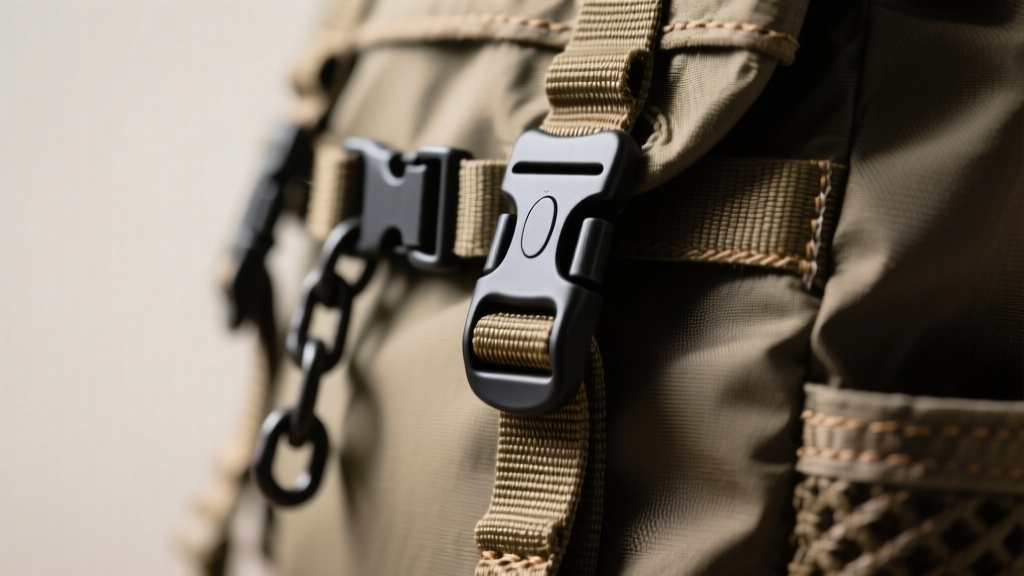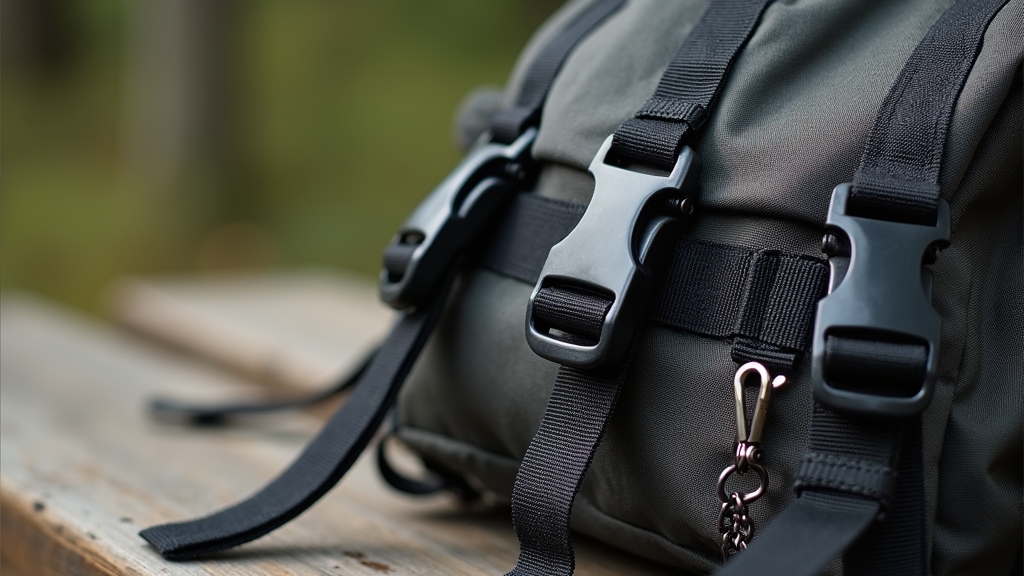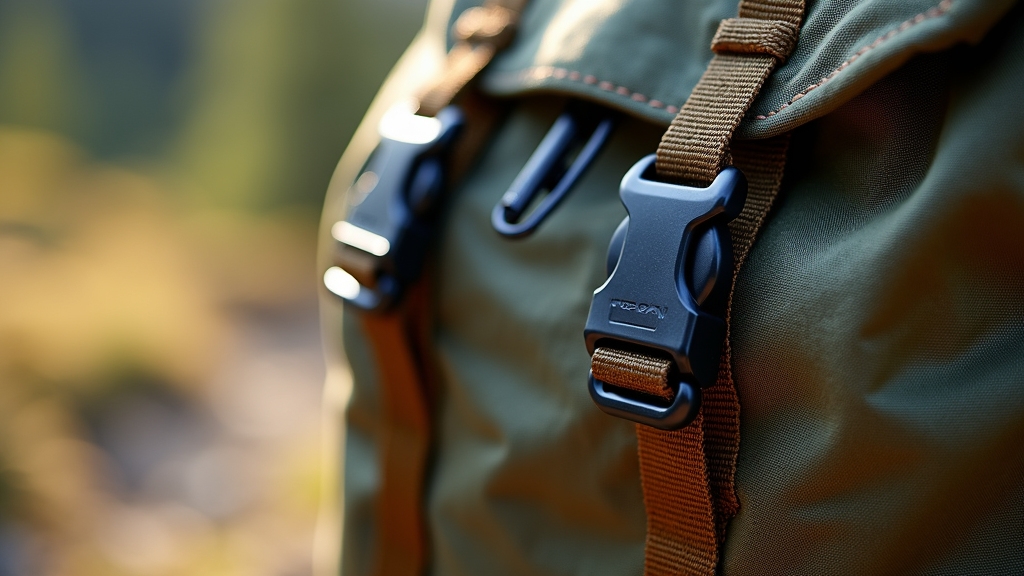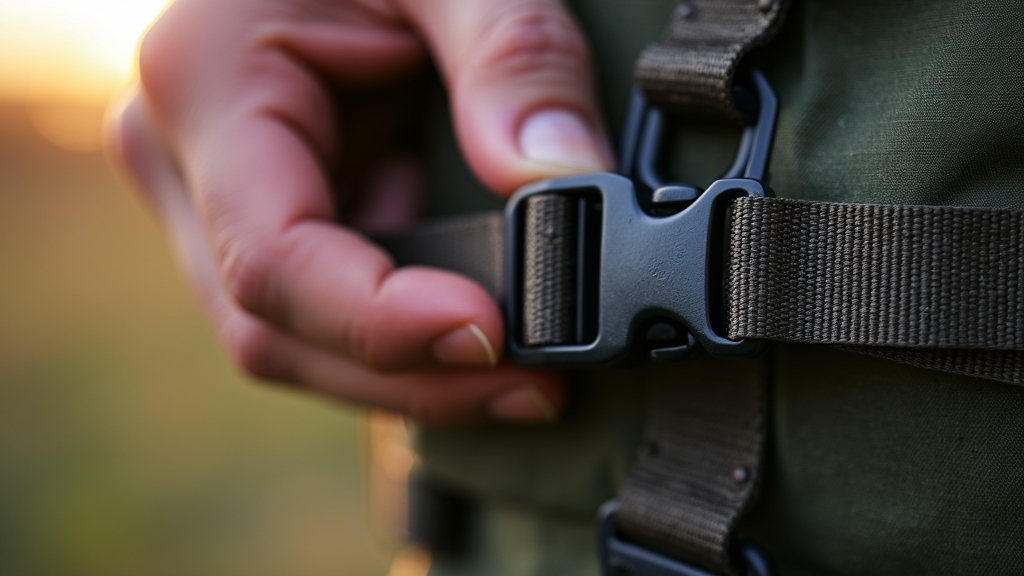
The clips on backpacks are typically called side-release buckles, carabiners, compression buckles, or D-ring clips. You’ll find plastic or metal side-release buckles that fasten and adjust straps easily, while carabiners attach external gear securely.
Compression buckles help tighten loads to prevent shifting, and D-rings serve as versatile attachment points. These clips vary in material and strength, impacting durability and function. Understanding these details can greatly improve how you use your backpack’s clips for different needs.
Key Takeaways
- Backpack clips commonly include side-release buckles, ladder locks, carabiners, D-rings, and compression buckles for securing straps and attaching gear.
- Side-release buckles are plastic or metal clips that fasten straps quickly with a simple squeeze to release.
- Carabiner clips are metal, spring-gated clips used to attach external gear or accessories to backpacks.
- Sternum clips are specialized clips that connect shoulder straps, improving weight distribution and comfort.
- Compression clips tighten the backpack load to reduce bulk and prevent shifting during movement.
Common Types of Backpack Clips

When selecting backpack clips, you’ll encounter several common types designed for specific functions and durability. Buckle clips, like side-release buckles and ladder locks, secure straps and close compartments efficiently.
Carabiner clips, typically D-shaped metal with a spring-loaded gate, attach external gear such as water bottles or keys. These clips are often made from aluminum or steel to ensure robustness and corrosion resistance. They are especially useful for attaching items that need to be quickly accessed or removed during travel.
Hook and loop fasteners (Velcro) provide quick access by fastening pockets or compartments.
MOLLE clips use webbing and snap closures, ideal for tactical backpacks requiring modular attachments. This system is designed to be highly customizable and secure, accommodating various gear sizes and configurations.
Utility clips incorporate multiple hooks and attachment points, sometimes with small compartments, enhancing gear security and organization. Each clip type balances strength and convenience, with metal clips offering durability and plastic variants prioritizing lightweight affordability.
Understanding these categories helps you match clip types to your backpack’s intended use for optimal performance, much like considering material choices can affect luggage flexibility and protection.
Materials Used in Backpack Clips
Although backpack clips come in various designs, their materials greatly influence performance and suitability for specific uses. Plastic clips offer lightweight, cost-effective solutions with versatile molding options, but they break easily under stress.
Plastic clips are lightweight and affordable but may fail under heavy stress or rough use.
Metal clips, typically aluminum or steel, provide superior strength and durability, making them ideal for heavy-duty and outdoor applications, though they lack flexibility. Composite materials like fiberglass or carbon fiber combine strength with lightness, fitting high-performance needs.
Nylon clips deliver strength and abrasion resistance with some flexibility, while polypropylene resists cracking and weighs less than nylon. When selecting clips, consider durability, weight, cost, and flexibility based on your backpack’s intended use.
Metal suits rugged environments, plastic fits everyday use, and composites work well when balancing load-bearing and weight.
Backpack clips are commonly used to attach items or adjust straps, enhancing overall functionality and convenience. Their design often reflects considerations similar to those in choosing luggage wheels, where durability and ease of use are prioritized.
Popular Clip Designs for Backpacks

What makes a backpack clip effective for your needs? Key designs include plastic side-release clips, prized for affordability and easy replacement, and metal buckles like aluminum or steel, which offer high strength for heavy-duty use. Regular maintenance and inspection help ensure these clips remain functional and durable over time.
Nylon clips feature expandable wings, providing moderate flexibility and tension adjustment. These clips are often made from flexible nylon material, allowing some give while maintaining secure fastening.
Composite clips blend lightweight construction with durability using materials like carbon fiber. Most clips incorporate quick-release mechanisms for secure closure and rapid access. This feature enhances convenience and safety by preventing accidental openings.
Plastic clips come in various colors and shapes, enhancing aesthetics. Some aftermarket clips feature interchangeable plate systems for mounting gear. Standardized sizes (1” to 2”) ensure compatibility across backpacks and accessories.
Choose clips based on your load demands: plastic for light use, metal or composite for rugged conditions, and nylon for a balance of strength and flexibility. Using protective accessories and preventive measures can also extend the lifespan of your backpack clips.
How Backpack Clips Enhance Functionality?
Because backpack clips serve multiple critical roles, they directly enhance the pack’s overall functionality by improving weight distribution, load stability, accessory attachment, security, and maintenance.
You rely on sternum clips to balance weight across your upper body, reducing shoulder fatigue. Compression clips tighten your load, preventing unwanted shifting.
External attachment clips expand carrying capacity, while secure main compartment clips protect valuables. Regular clip inspection ensures durability and safety.
Proper measurement including wheels and handles is essential to ensure compliance with size restrictions when traveling with backpacks that may be checked as luggage.
| Function | Role |
|---|---|
| Weight Distribution | Sternum clips balance load, reduce fatigue |
| Load Stability | Compression clips cinch and stabilize items |
| Accessory Attachment | Clips attach gear, hydration tubes, tools |
| Security & Maintenance | Secure closures; inspect clips regularly |
Choosing the Right Clip for Your Backpack

When selecting clips for your backpack, you need to match their type and material to your specific use and gear requirements. If you carry heavy equipment, metal clips like aluminum or steel provide the necessary strength. For international travel, securing your backpack with TSA-approved locks can offer additional security and peace of mind.
Plastic clips suit lighter, everyday loads. Consider clip functionality: side-release buckles offer quick fastening, ladder locks adjust strap length securely, and carabiners attach external gear efficiently.
Compatibility is essential—ensure clip dimensions fit your backpack’s webbing or attachment points. Many backpacks feature MOLLE webbing or daisy chains designed specifically for external clip attachment.
Prioritize clips that operate smoothly with one hand and avoid designs causing friction or discomfort. For tactical setups, MOLLE clips support modular pouch attachment.
Ultimately, assess wear resistance by choosing clips made from durable materials like specialty plastics (POM) or composites to withstand environmental exposure and frequent use.
Durability and Strength of Different Clips
When you compare plastic and metal clips, you’ll quickly see that metal clips really take the lead in terms of strength and longevity. They’re especially tough when it comes to handling heavy loads or dealing with harsh conditions.
Metal clips are known for their durability and strength, making them ideal for demanding uses. On the other hand, if you’re looking for something a bit lighter, composite clips might be the way to go. They manage to offer durability that’s pretty close to what metal clips provide, but without the added weight.
However, it’s important to consider the damage potential when using clips under extreme stress, as improper handling can affect their performance.
Plastic vs Metal Strength
Although plastic clips dominate backpack hardware due to their light weight and cost-effectiveness, they don’t match metal clips in strength and durability. Plastic clips usually fail by cracking under heavy loads or impact. They degrade faster when exposed to UV rays or extreme temperatures.
They’re ideal for everyday use where weight saving and affordability matter more than heavy load capacity. Material choice affects strength and weight: metal clips are sturdy but heavier; plastic/nylon are lightweight and corrosion-resistant. Choosing the right clip can also impact the overall comfort and look of the backpack.
Metal clips, made from aluminum, steel, stainless steel, or titanium, offer superior tensile strength and longer lifespan. Aluminum resists corrosion and is light but less strong, while steel provides high strength with potential rust risk if untreated.
Titanium balances strength and weight ideally. Metals bend under extreme stress, giving you warning before failure. This makes them better suited for heavy-duty, outdoor, or load-intensive applications despite their added weight.
Composite Clip Durability
Metal clips excel in strength but add weight and can suffer corrosion, while plastic clips offer lightness at the expense of durability. Regular maintenance and cautious handling prevent premature clip failure, similarly to how wheel lifespan can be extended with proper care.
Composite clips strike a balance by blending fiberglass, carbon fiber, and resin to achieve high tensile strength close to or exceeding some metal clips without the added weight. Their layered internal structure distributes stress evenly, reducing snap risk under sudden loads.
You’ll find composites resist UV damage, moisture, and chemical exposure far better than plastics or metals, maintaining flexibility across temperature extremes. This makes them ideal for demanding outdoor use. Ergonomically, composite clips allow complex shapes and quick-release features without sacrificing durability.
Though pricier due to advanced materials and manufacturing, composites deliver superior load capacity and corrosion resistance, making them a practical choice when you need both strength and lightness.
In addition, composite clips are more resistant to environmental stressors like dirt and weather, enhancing their environmental resistance compared to other materials.
Longevity in Harsh Conditions
Because backpack clips face varied and extreme conditions, their longevity hinges on the interplay of material strength, environmental resistance, and mechanical design.
Metal clips offer superior load-bearing capacity and impact resistance, lasting over 5 years under harsh use. Metal options like stainless steel and aluminum provide corrosion resistance and a sleek appearance, making them ideal for heavy-duty, high-stress, or marine environments.
Additionally, metal clips can incorporate locking mechanisms to enhance security in demanding situations. Plastic clips resist corrosion but break under heavy loads, while nylon clips provide flexibility yet degrade faster under UV exposure.
Composite clips balance strength and weight, extending lifespan but at higher cost.
| Clip Type | Strength | Environmental Resistance |
|---|---|---|
| Metal | Very High | Moderate (prone to rust) |
| Plastic | Low to Moderate | High (corrosion resistant) |
| Nylon | Moderate | Moderate (UV degradation) |
Choose clips aligned with your load demands and environment for best durability.
Specialized Clips for Outdoor and Travel Use
When you venture outdoors or travel extensively, specialized clips on your backpack play a crucial role in functionality and durability.
Side release buckles let you quickly fasten and adjust straps like sternum and compression straps with one hand. Compression buckles tighten and stabilize your load, reducing bulk and sway during movement. Regularly inspecting and maintaining these clips can prevent mechanical jams that hinder their performance.
Side release buckles enable quick one-handed fastening, while compression buckles stabilize and minimize load sway.
D-ring clips offer versatile attachment points, perfect for carabiners or tools, while carabiner clips provide strong, reliable external gear attachment. These clips are popular among outdoor enthusiasts and commuters.
Magnetic quick-release clips combine speed and convenience, ideal for active scenarios. Materials vary: plastic clips are lightweight but less durable; metal clips, often anodized aluminum or steel, provide maximum strength and corrosion resistance. Some clips blend materials for balanced durability and ease of use.
Frequently Asked Questions
Can Backpack Clips Be Replaced if Broken?
Yes, you can replace backpack clips if they break. Plastic clips are the easiest to locate and swap out, while metal clips last longer but might be harder to obtain replacements for.
Just make sure you check the clip type, size, and strap width before buying. You’ll need some basic tools and care to avoid damaging straps. Ordering from specialty suppliers or outdoor gear shops usually ensures compatibility and durability.
How Do You Clean and Maintain Backpack Clips?
You clean backpack clips by rinsing with water, scrubbing gently with mild soap, and using toothbrushes or Q-tips for tight spots. You maintain them by inspecting for damage, lubricating metal parts with silicone spray, avoiding overload, and storing the backpack in a dry, cool place.
Always replace worn or cracked clips promptly to guarantee safety and functionality. Keep spare clips handy for quick fixes during frequent use.
Are There Clips Designed for Child Safety on Backpacks?
Yes, backpacks can have clips designed specifically for child safety. These include locking side release buckles that prevent accidental opening but allow caregiver access.
You’ll find detachable harness clips for tethering your child in crowded spaces, and brightly colored or glow-in-the-dark pull tabs for easy visibility.
Safety clips often feature rounded edges, non-toxic materials, and breakaway mechanisms to prevent injury. Using them helps you maintain control while letting your child stay independent.
Can Clips Cause Damage to Backpack Fabric Over Time?
Yes, clips can cause damage to your backpack fabric over time. Friction from clip edges rubbing against fabric leads to abrasion, especially if your straps are misaligned or clips shift during use.
Uneven load distribution strains both clips and fabric, accelerating wear. To minimize damage, regularly inspect and clean your backpack, avoid overloading, and replace worn clips promptly.
Proper clip selection and secure attachment also help protect your backpack’s material integrity.
Do Backpack Clips Affect the Overall Weight of the Bag?
Imagine adding a few paper clips to a thick book. They barely change its weight. Similarly, backpack clips add negligible mass, usually just a few grams.
What really matters is how you use them: clips like hip belts redistribute load from shoulders to hips. This improves comfort and posture without altering total weight.
Secure Every Adventure with the Right Backpack Clip Choice
Now that you know the common types and materials of backpack clips, you can see how these small components act like the backbone of your pack’s functionality. Whether it’s the sturdy side-release buckles or specialized clips for outdoor gear, selecting the right one guarantees durability and ease of use.
Think of these clips as tiny engineers, holding everything together securely while adapting to your travel or hiking demands with precision and strength.
